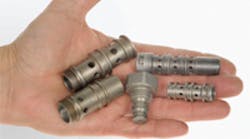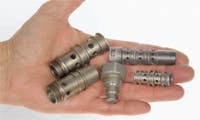A new generation of honing technology is playing a vital role to improve the performance of hydraulic components, providing manufacturers a unique ability to size and finish valve bores precisely. The new honing technology, known as precision bore machining, or multi-stroke honing, can control bore size with quarter-micron accuracy (0.00001 in.), correct geometric errors in the bore, and produce a specific surface finish to improve lubrication and sealing properties.
What's this mean in terms of performance in a cartridge valve? Multistroke honing straightens a valve bore and precisely sizes it. This allows tight clearance between the bore and mating parts, producing low port-to-port leakage. The tight fit and precise geometry help reduce valve hysteresis and permit higher operating pressures and greater system efficiency overall. Finally, multi-stroke honing creates surface finishes with high wear resistance for long valve life. The crosshatch finish left by multi-stroke honing improves the uniformity of the lubricating film between sliding parts for consistent performance, especially in adverse operating conditions.
Multi-stroke honing
Multi-stroke honing is an abrasive machining process whereby a tool with expanding stone assemblies rotates in the cylinder bore, while the tool or the part reciprocates rapidly during the process. A multi-stroke honing tool may contact the entire length of the part's bore, giving this process the ability to correct geometric error in the bore shape. Honing generates little heat and stress, so the surface integrity of the bore is consistent and can be finished to a specified level of roughness.
It may seem a contradiction, but attaining performance enhancements with honing actually lowers costs for the valve maker and can create opportunities to offer longer product warranties. Here's how. Any valve manufacturer can purchase basic screw machined components from high-quality vendors, and many hole-making operations — such as boring, drilling, and reaming — can produce fairly tight tolerances. However, tolerances for these parts rarely meet the requirements of cartridge valves. A bore tolerance of 0.002 in. (0.05 mm) is considered acceptable by most machinists, whereas honing produces bore tolerances of less than 0.00005 in. (less than 0.0013 μm).
High quality finishes require a machining operation that's easy to "dial in" with great precision and remain stable once the process is established. For example, a lathe may just meet a certain tolerance value, but even a little tweaking can cause it to jump out of spec. A computer-controlled hone can easily get within 0.000010 in. of a specified size — and with the resolution of today's machines, variation is slight.
Size control is not the only issue. Honing allows tailoring of the surface finish, then leaves a crosshatch pattern on the bore of the cage. Alternative processes, such as turning and single-pass honing, cannot produce multi-stroke honing's characteristic crosshatch pattern on the bore surface.
The beneficial crosshatch pattern left by multi-stroke honing can be visualized as two opposing helical patterns that remain on the bore surface. This is the same surfacing technology used in automotive cylinder bores, particularly in performance racing. The crosshatch pattern can be controlled to produce a specific angle and depth, which cartridge valve and other manufacturers use to control the retention and distribution of lubricating oil films. A crosshatch surface ensures a consistent full-length flow path for lubrication around the mating parts of the valve.
Conversely, bores finished with single- pass honing, or a single-point tool, will have a faint, single helical pattern on the surface. The resulting "threaded" finish can lead to lubricating films being pushed out of the bore.
In addition to the crosshatch, honing also allows tailoring of the bore's surface finish to a desired specification. Too smooth a surface finish can actually diminish the lubrication between mating parts, increasing friction. It is common for manufacturers to monitor average surface roughness, which influences the fit between mating parts, or the average valley depth, which influences lubricant retention capability.
Multi-stroke honing also improves the performance of valves by correcting geometric error in the part. A multistroke honing mandrel — which contacts almost the full length of the bore while the part reciprocates — can correct geometric error (straightness, cylindricity, etc.) from screw machining or distortion from heat treating or stress relief. In contrast, a single-pass honing tool is tapered, so only a part of the tool's length represents the final size. This part of the single-pass honing tool tends to follow the existing path of the bore, so a curved bore will tend to remain unchanged. This is especially true for parts with a length/diameter ratio exceeding 1.0.
The controlled fit, finish, and clearance produced by multistroke honing results in a more efficient hydraulic circuit. The precise size and surface finish help eliminate port-to-port leakage. Honing significantly reduces hysteresis and improves the low-voltage reliability of electrically actuated valves.
What's on the horizon in honing technology? The latest generation of machines is designed to function as fully automated cells with integrated air-gaging feedback for closed-loop control of the process. It sorts parts by size after processing, and all the parts fall within a size range of 0.000125 in.
This discussion was provided by Rich Moellenberg, manager, Global Technology Support, Sunnen Products Co., St. Louis. For more information, call (314) 781-2100 or visit www.sunnen.com


